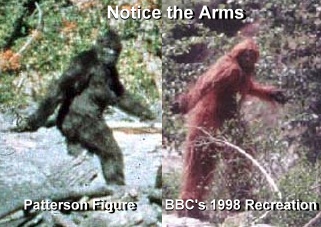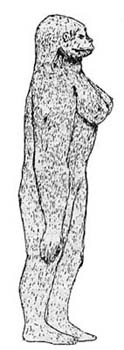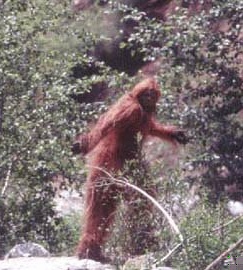
|
||||||||||||||||||
|
|
||||||||||||||||||
|
| ||||||||||||||||||
  






  









| ||||||||||||||||||
The Truth Before our Eyes
 |
By John Green
Almost thirty-seven years ago two young men from Yakima, Washington,
Roger Patterson and Bob Gimlin, emerged from a remote forest in the northwest
corner of California with a brief 16-millimeter film showing a hairy creature
walking along a sand bar on its hind legs, and the debate on whether their
film shows an unknown animal or a man wearing a fur suit has gone on ever
since.
|
Click here for details. |
|||
|
|||
|
|
|||
Now, thanks to a new book on the subject, that debate should be at an
end. The answer has been in plain view all along, the creature on the
film holding it, quite literally, in its arms. And that answer, ironically,
is the opposite of the one in the book. The creature can not be a man
in a suit.
The writer of the book
claimed to have cracked the case by finding two key witnesses: the man
who wore the suit, a Yakima acquaintance of Patterson and Gimlin named
Bob Heironimus, and the man who (falsely) claims he sold a gorilla suit to Patterson and told
him how to modify it, Philip Morris, a costume maker from Charlotte, North
Carolina.
The Heironimus story is not new. It surfaced several years ago one of the many unsubstantiated claims to have been ?the man in the suit? that crop up from time to time. Phillip Morris appears to be a real find, a man who actually was making gorilla costumes in 1967 and who says he remembers selling one to Roger Patterson.
One of the things that Morris is quoted as saying is that the way to make the arms in the suit look longer than human arms is to extend the gloves of the suit on sticks.
Many people have noted that the arms of the creature in the film look unusually long, almost as long as its legs. Some, including myself in 1968, have published estimates of their length. No one went on to deal with the question of how human arms could be extended to match the extra length and what such an extension would look like.
There is no way to establish for certain if any of the dimensions estimated for the creature in the film are accurate, but what can be established with reasonably accuracy is the length of the creature?s legs and arms in relation to one another. From that ratio, which anatomists call the ?intermembral index?, it is simple to calculate how many inches must be added to the arms of a man of known size in order to make his arms long enough to fit the supposed suit.
In my own case the answer turns out to be about 10 inches. But in order for the arms to bend at the elbow, which they plainly do in the movie, all of that extra length has to be added to the lower arm.
The result, in my case, is about 12 inches of arm above the elbow and 29 inches below it?almost as much of a monstrosity as Edward Scissorhands.
The creature in the movie has normal-looking arms. Many issues in the
long debate about the movie remain unresolved?what the film speed was, whether
a man could duplicate the creature?s unusual bent-kneed walk, whether its
behavior was normal for an animal, whether the tracks left on the sandbar
could have been faked, and so on?but all of them turn out to have been irrelevant
to the main issue. It cannot be a man in a suit.
My measurements of the film, made 36 years ago, gave the creature arms that
were 30 inches from the shoulder to the wrist and legs that were 35 inches
from the hip to the ground. My own measurements are about 24 inches from
shoulder to wrist and 40 inches from hip to ground.
Only the ratios of the measurements matter, the actual size of either the
human or the creature makes no difference, and the ratiosfor creature and
human are so much different that precise accuracy of the measurements is
not significant either.
The much ridiculed Patterson-Gimlin film does not show a man in a suit.
What about Roger Patterson buying a gorilla suit? Philip Morris does not
claim to have records, only a memory. Neither Mrs. Patterson nor Bob Gimlin
remember Roger having any such suit. But Roger was trying to make a Bigfoot
documentary at that time and most such documentaries contain re-enactments
by someone wearing a fur suit. If he did buy one it has little more significance
than an apprentice carpenter buying a hammer.

|
|
Eyewitness sketch of a female sasquatch, showing a musculature and body proportions similar to the Patterson figure. This one was observed for several minutes by hiker William Roe on Mica Mountain in British Columbia, Canada, in 1955. This drawing was made shortly after the 1955 sighting, but was not published until 1968, one year after the Patterson footage was obtained. |
The descriptions of the suit by the two key witnesses are totally contradictory. Morris is quoted as having described his suit in precise detail, and how he made it. The suit had six separate pieces: a head a body (arms, torso and legs), two hands and two feet. A knitted cloth material served as a backing to thousands of synthetic nylon strands called dynel, which were driven by a powerful knitting machine with needles through the knitted cloth material and then pulled back through to the other side. It had a 36-inch zipper up the back.
Bob Heironimus is also quoted, saying that Patterson made the suit himself by skinning a dead horse and gluing fur from an old fur coat on the horsehide. It was in three parts, head, torso and legs that felt like big rubber boots and that went to his waist.
He thought the feet were made of old house slippers. The suit weighted 20 or 25 pounds and he needed help to get in and out of it. It also smelled bad. ?It stunk. Roger skinned out a dead, red horse.?
--------------------------------
By Jeff Meldrum Ph.D.
Associate professor of Anatomy & Anthropology Idaho State University Pocatello,
Idaho
It has been obvious to even the casual viewer that thefilm subject possesses arms that are disproportionately long for its stature.
John Green is a veteran researcher into the question of Sasquatch or Bigfoot. He was among the first to view the film captured by Patterson and Gimlin and has studied it intensely in the intervening years. His recognition of the significance of the unhumanly long arms of the film subject is a point that has not previously been articulated in such a straightforward manner. It is such a fundamental observation that it is considered a breakthrough in assessing the validity of this extraordinary film.
Anthropologists typically express limb proportions as an intermembral index (IM), which is the ratio of combined arm and forearm skeletal length (humerus + radius) to combined thigh and leg skeletal length (femur + tibia) x 100. The human IM averages 72.
The intermembral index is a significant measure of a primate's locomotor adapatation. The forelimb-dominated movements of the chimp and gorilla are reflected in their high IM indices of 106 and 117 respectively.
 |
|
You are invited to make measurements and IM calculations on your own using frame 72, above. |
|
|
 |
|
|
Identifying the positions of the joints on the film subject can only be approximate and the limbs are frequently oriented obliquely to the plane of the film, rendering them foreshortened to varying degrees. However, in some frames the limbs are nearly vertical, hence parallel to the filmplane, and indicate an IM index somewhere between 80 and 90, intermediate between humans and African apes.
In spite of the imprecision of this preliminary estimate, it is well
beyond the mean for humans and effectively rules out a man-in-a-suit explanation
for the Patterson-Gimlin film without invoking an elaborate, if not inconceivable,
prosthetic contrivance to account for the appropriate positions and actions
of wrist and elbow and finger flexion visible on the film. This point
deserves further examination and may well rule out the probability of
hoaxing.
Dr. Meldrum is an expert in primate anatomy and locomotion. He recently coedited, From Biped to Strider: The Emergence of Modern Human Walking, Running, and Resource Transport.
-------------------------------------